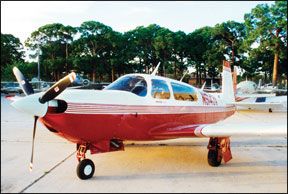Mooneys have always enjoyed a reputation for being fast, easy-to-fly cruisers with average payload and a somewhat tight cabin. But the reality is that theyve been more efficient than fast. Bonanzas and Cessnas gas-thirsty 210 outrun most Mooney models but on balance, no airplane company has managed to squeeze as many knots out of as few horsepower. The sore-thumb exception to this is the Mooney M20M/TLS/Bravo series. For this model, Mooney entered the go-for-broke speed sweepstakes by stuffing the largest Lycoming engine it could find into what is, by even modern standards, a slick, drag-free airframe. The result? A fast cruiser but one limited in range by the Lycomings poor fuel specifics.
The M20M was clearly a departure for Mooney. Its previous entry into the fast-cruise turbocharged market had been the M20K/252/TSE, with a 210-HP Continental TSIO-360. It sipped fuel and had decent if not blazing cruise speed, but engine service issues troubled that model. Maintenance issues would dog the M20M but were sorted out with an engine modification. Buyers of the TLS Bravo are somewhat of a different breed. They gravitate to the type for raw speed and don’t care what it costs to get it. Said one owner:
“The TLS lacks the efficiency of the rest of the product line, but speed, rather than efficiency is what this model is all about.”
History
The M20M TLS/Bravo was introduced in 1989 as part of Mooneys expansion of its model line. In some ways, it was a case of making lemonade from lemons. The year before, the innovative Porsche-powered PFM had appeared, debuting a fuselage stretched from the M20J/M20K series. The PFM proved a dud for Mooney, mainly because it lacked the speed and performance of even the popular four-cylinder M20J/201. At the time, Mooney still had the M20K/252 in the line, but it became evident that buyers were gravitating towards ultimate performance and away from the traditional Mooney efficiency. Mooney dropped the 252 the following year.
The TLS truly was a different kind of machine. Larger aft cabin windows are the most obvious exterior change from the 231/252 models. The rear seat and aft bulkhead have been moved back to provide more interior space but preserve basically the same baggage area.
Also, the panel was redesigned, an artifact of the PFM control group requirement. This proved to be a mixed blessing. It does provide more knee room at the base of the panel and better organization, but the tradeoff is less visibility over the glareshield. Some owners say the effect is nearly claustrophobic. Realizing this, in its new Acclaim in 2007, Mooney lowered the panel more than two inches, restoring the view over the glareshield.
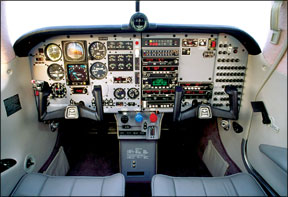
To balance the weight of the heavy Lycoming, there’s a slight increase in elevator area and a second battery located in the tail cone. The engine cowl, which has gaping, un-Mooney-like air in
takes-including a big NACA-type duct to supply air to the intercooler, is lighter than the 252s. Electrically operated, infinitely adjustable cowl flaps are included for cooling.
The landing/taxi lights are mounted in the wing leading edge in the TLS, a design change that both improved bulb life and lighting performance. In addition to dual batteries, the considerable electrical demand is supplied by dual, 70-amp alternators. Available equipment includes a mechanically driven standby vacuum pump. It automatically engages if the primary system fails. Later models were equipped with TKS de-icing systems.
Another first on the TLS is rudder trim. Its actually an electrically actuated, bungee-controlled rudder bias system. While maintaining yaw trim on smaller-engined Mooneys is not a high-workload affair, it is on the TLS, especially for a 20-minute climb into the teens or flight levels, where the airplane is happiest. For the TLS, Mooney didnt sell stripped down models. It came complete with a 115 cubic-foot oxygen system, speed brakes and a high-end avionics package. Quite a few TLS examples have the Bendix/King electronic horizontal situation indicator (EHSI) as an option and many have been upgraded with Garmin 400/500-series navigators. Bendix/King equipment was standard in the M20M until 1999, when the Garmin GNS navigators appeared in the model. In 2003, the Bravo DX was offered, with Garmin 430/530 suites. In 2006, the last model year for the M20M, the GX version has the Garmin G1000 as standard gear. All of the recent models have Bendix/King KFX225 autopilots, while earlier versions have KFC150s.
Engine, Performance
For power, Mooney picked the 270-HP Lycoming TIO-540-AF1A, a ground-boosted variant vaguely similar to the Piper Navajos powerplants. Although it has plenty of power for good climb rate, the Lycoming has poorer fuel specifics than large-displacement Continentals and high fuel burns are the result.
Further, the engine soon proved to be a maintenance hog in the form of excess exhaust valve guide wear. Owners were having to do expensive top overhauls barely a quarter of the way to TBO, something Lycoming engines arent noted for.
Lycomings fix was the so-called “wet head” which channels oil into the exhaust valve guides. This yielded a new engine designation, the TIO-540-AF1B, and it appeared in production models in 1996. It was also retrofitted to earlier TLSs. The B engine gave the airplane its new name-the Bravo.
You can immediately see if the mod has been done. Oil is fed through a series of external hoses leading to each head, where the oil is directed into a groove milled into the valve guide, drawing off heat and reducing wear. The mod worked. Premature valve wear declined and the engine is likely to make its 2000-hour TBO if flown regularly and maintained well. Overhaul cost, however, is quite high-well north of $40,000 in most cases.
Service history wise, the turbo installation is neither the best nor the worst. Our safety review of the airplane found three instances of fire caused by exhaust system leaks at the tailpipe V-joint. Given the airplanes small population, we consider that a fairly high occurence.
To feed the thirsty engine, fuel capacity was increased to 96 gallons (89 gal/534 pounds usable). Best angle climb (Vx is 80 KIAS) produces a very high 703 feet/NM climb gradient. It also means you have no forward visibility. Best rate (Vy is 105) results in an impressive 1230 FPM. A more sedate cruise climb speed of 120 to 140 KIAS should be used. The latter still produces a healthy 800 FPM, with good forward visibility and engine cooling.
Flight planning is important in the TLS. You can storm along at FL250 truing 220 knots-in the speed range of many turboprops. But at 20.5 GPH, endurance is only about three hours, so by modern standards, range is cramped. This can be addressed directly by installing long-range fuel tanks under an STC arrangement with Monroy Aerospace.
Setting power for best economy rather than best power costs only two or three knots at most altitudes and power settings in exchange for two or three gallons less fuel consumption. Compromising on lower power settings, particularly where winds are in your favor, can extend endurance out to as much as six hours plus reserve.
At FL 200, maximum cruise power of 2400 RPM/34 inches MP/17.6 GPH results in 204 KTAS. Cutting power and reducing fuel flow to 16.6 GPH still gives 202 knots. At below oxygen levels, the TLS still can churn out impressive speeds: 195 KTAS at 12,000 feet.
HANDLING
Pilots with Mooney experience adjust to the TLS easily. In some respects, there
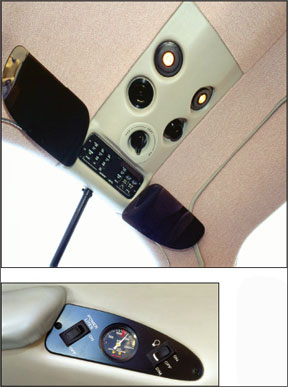
are more things to attend to, including the rudder trim, but these are offset by simpler systems. Power settings are made easier by the variable density wastegate controller on the turbocharger. Overall, the airplane is simpler to fly than the M20K, which requires engine operating finesse. Rotation at takeoff and getting the attitude right for landing are a bit easier. CG is a bit further aft, and the elevator is a tad more powerful.
Pilots used to Beechcraft and Cessnas will note some differences.
First, you sit almost on the floor, rather than on a chair. Eye level is low. And the Mooney is relatively low to the ground, which compounds sight picture over the nose.
The shock absorption in the Mooney gear design is a low-maintenance rubber donut system rather than oleo struts, but yields a rougher taxi ride.
Proper speed control is essential. Until you become practiced, it takes effort to land on the mains. If your speed is too high, you’ll float forever. Try to stuff it on the runway prematurely and you’ll be rewarded with a world-class case of porpoising, a common accident cause.
Otherwise, the TLS has good flight manners. The controls-particularly ailerons-feel a bit heavy. Rudder is the lightest of the three axes. Control actuation is via push-pull tubes rather than cables, which makes for a tight, direct connection. Properly rigged, Mooneys have good, precise handling and are fun to fly on instruments. And they handle turbulence well.
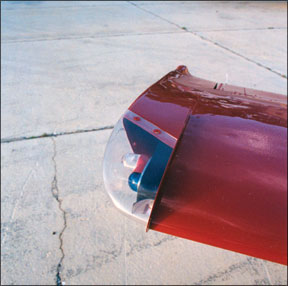
Optional Precise Flight speed brakes were offered starting with the 231 and 201 and are standard on the TLS. Most pilots think theyre the best addition to a Mooney (and a lot of other airplanes, as well). They simplify management of power, engine temperature and speed in descent.
Another area in which Mooneys have been improved-starting with later versions of the 201-is gear speed. Both gear and flap extension speeds were woefully low, particularly when operating in high density areas with a wide mix of traffic. Flap extension speed is still low on the TLS (110 KIAS), but gear extension speed is 140 knots on the TLS (Vlo for retraction is still 106 knots, however). Once the gear is out, maximum speed is 165 knots. This, in combination with the speed brakes, makes penetration descents possible without worrying about having to idle the engine.
One quirk of Mooneys is that extending the flaps requires significant pitch-down trim. The lower the indicated airspeed, the less obvious the trim change. However, transition from power-off or low-power approach with full flaps to a go-around or missed approach produces an immediate pitch up that requires a lot of pitch force or quick action on elevator trim to compensate for. This can be distracting and unsettling unless its anticipated.
LOADING/COMFORT
Mooney pilots and passengers have been better treated since the introduction of the first stretched fuselage, the Executive, in 1968. Improvements in interior design have made better use of available space. The TLS is a big improvement for both front- and rear-seat passengers. Rear-seat leg room is better, and the illusion of space created by the larger windows helps. It also improves pilot visibility to the rear.
Baggage space is adequate at just under 21 cubic feet. Maximum structural load is 130 pounds. Seats in the TLS are three-way adjustable and the front seats include an adjustable (inflatable) lumbar support. A nice touch is the way the rear seat backs fold down to provide a cargo compartment in back. The rear seat cushions can be yanked out to allow this.
Payload, as mentioned earlier, is adequate, even with full fuel. The TLS is not the load hauler that airplanes like the Cessna 210 or Bonanza are, but its in the
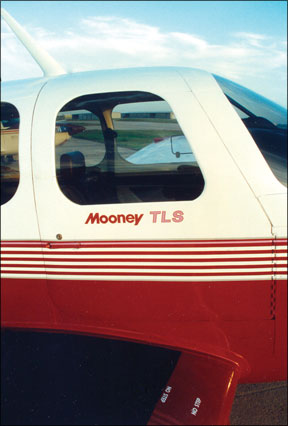
ballpark. Two people and some bags or two big and one or two small people with full fuel. But generally, Mooneys just arent four-person airplanes so if payload and range are key to your operation, think about a Cessna 210 or Bonanza A36 instead.
MAINTENANCE
In previous reports, owners have noted recurring problems with landing gear retraction. One noted: “Fortunately, the problem was getting the gear up rather than…down.” It happened three times to this owner. The limit switch was replaced each time. “That it happened once would be troublesome. That it happened three times is inexcusable,” he said. “Having to fly in excess of 10 hours with the gear down certainly defeated my purpose in acquiring such a plane.” The other owner said it occurred three times. Retraction tests did not uncover the problem until the third event. It was traced to a faulty microswitch.
Another owner said his service facility does not think the landing gear “biscuits” will last 300 hours under the heavier weight of the TLS. Reaction to Mooney support varies. Some term it good, particularly during the early teething pains of the first production airplanes. Others are not so sanguine, especially following one of Mooneys bankruptcies. As of early 2007, the companys new CEO, Dennis Ferguson, told us service and support is high on the list of things to improve.
Owner Feedback
I traded in a 1997 Mooney MSE for a new 2000 Mooney Bravo. During the past six years and 900 hours, the Bravo has ventured from its roost, Islip, on Long Island, on many long cross-country adventures in all kinds of weather. In addition to all of the local flights up and down the East Coast, we have been to Aspen, Las Vegas, The Turks and Caicaos, the Cayman Islands and Canada.
Mooney has advertised their aircraft as personal airliners. The Bravo, when properly equipped with known ice TKS and extended range tanks, is as close to an airliner as a piston single can get. The turbo gives you flight planning options that a normally aspirated engine simply cannot. Combining the turbo performance with TKS has allowed me to fly missions that would be impossible in any of Mooneys competitors aircraft.
I cannot praise the TKS system enough. I have had an inch and a half of ice on the landing light plastic cover without a speck of ice anywhere else on the airframe. On one Easter Sunday, my family and I were in a Norfolk FBO with a bunch of other pilots planning on returning to the Northeast to get back to work on Monday. Icing was in the forecast.
The other pilots were nervous. They were debating whether or not to scud run all the way up the coast. One Piper pilot asked me how I could file IFR and fly my family into icing conditions. He ended up scud running. We broke out of the clouds in a few minutes at about 10,000 feet and flew home in clear sunny VMC. We never had to turn on the TKS but couldnt have flown without it.
All of this utility of course comes at a price. The MSE actually got 21 nautical miles to the gallon, better than my Jeep! I fly the Bravo at a conservative 32 inches manifold pressure, 2400 RPM and no more than 1650 degrees TIT. Fuel burn at these power settings averages out to 20 gallons per hour or nine nautical miles to the gallon. This is about four gallons more than the POH advertises and why you need the extended range fuel tanks. You can achieve all of the POH stated airspeeds, although at higher than stated fuel burns.
Real-world indicated air speeds seem to work out to 170 knots at 5000 to 7000, 180 knots at 10,000 feet, 190 knots at 15,000 to 18,000, 210 knots at FL 250. All of these speeds are at a 20 gallon per hour fuel burn, so you can see the efficiency of flying high. In real world Northeast IFR flying, ATC seems to keep you between 5000 and 10,000 feet. An Ovation is faster and more fuel efficient at these altitudes.
On longer cross-country flights, I will file for 10,000 feet westbound into a headwind. I will file for 15,000 or 17,000 feet on the eastbound tailwind leg. We routinely see 225- to 250-knot ground speeds at these altitudes with a tailwind. Passengers don’t like wearing the oxygen masks.
My best ground speed in the Bravo was 326 knots at FL 230! The Bravo could benefit from a 100-pound gross weight increase. I have loaded the airplane down with TKS, extended range fuel tanks, radar altimeter, a Garmin 530/430 stack, Argus 7000 CE map, Skywatch, Stormscope, standby electric attitude indicator and so on.
The airplane has plenty of reserve power. Monroy Aerospace, which holds the STC for the extended range fuel tanks, told me that they obtain FAA ferry permits for flights at over 300 pounds above gross. The weight constraints require careful planning. Sometimes, we have to FedEx bags and ski equipment to our destination hotels. I have a bench back seat which can hold three children. The Bravo can be flown with four adults or two adults and three children with a partial fuel loading. In the summer, you can drain out most of the TKS fluid.
The Bravo is a lot more expensive to operate than an MSE. The turbo has not required any servicing expense. The expense comes from servicing all of the complex systems in the aircraft that allow the Bravo to be a “personal airliner.” The sophisticated Bendix/King autopilot can be expensive to maintain. I have a service contract with Bendix/King that now costs about $1800 a year.
My Bravo has received impeccable service from the dealer. I figure that it has cost between $20,000 and $30,000 a year to maintain the aircraft. The dealer shop that I used is probably the most expensive in the business. When you fly hard IFR in a single and long overwater flights, the expense is worth it.
Now it is time to talk about Mooney. They have had three owners, seven or eight CEOs and been in and out of bankruptcy since I bought the new MSE in 1997. The current owners eject CEOs like brass from a Colt .45. I lost my warranty, sweated out the bankruptcy and took a $100,000 hit in resale value when the new owners dropped the price on new models. My airplane was out of service stuck in the factory for six months because the factory had installed some flush rivets instead of standard rivets.
Sounds pretty awful, doesnt it? Mooney is blessed with a great design and true craftsmen that take pride in their product. I attended the MAPA October convention at the factory. You could see the dedication of the workforce when you toured the factory. The company appears to be on the road to success with a better customer service attitude and great new models. All they have to do is stop ejecting the brass!
Lycoming dropped the ball in the customer service department in regard to the crankshaft AD recall. However, the 270 horsepower Lycoming in the Bravo is a great engine. There were problems with the first editions of the engine when they first came off the line. Since the Bravo engineering fix, the engine has been bulletproof. My engine starts reliably in any weather and barely burns any oil. The automatic controller makes the turbo operation a snap. My shop states that the engines make TBO without cylinder replacements or costly repairs when they are run at the conservative 34/2400 1650 TIT power settings.
The Bravo is not inexpensive to properly maintain nor cheap to operate. However, its the most capable single engine all-weather piston you can buy. You will have to jump up to a turbine single to do better.
Bob Anderson
Islip, New York
I purchased a TLS from Mooney in late 1989, the first year of production. Performance is a real plus and meets the book values very closely. I normally fly in the mid-teens and get true airspeeds of 200 to 205 knots at 32 inches MP and 2400 RPM. Fuel burn at these conditions is 16.5 to 17 GPH. For a 600- to 700- mile trip with a cruise altitude of 15,000 to 17,000 feet, I plan on a fuel burn rate of 20 GPH for the first hour and 17 GPH for the rest of the trip.
I fly the aircraft on business trips on the West coast and have been coast to coast a couple of times. I can really recommend the TLS for cross-country travel. Depending on wind and weather, I will fly 600 to 750 mile legs, or about 3 to 3.5 hours. This is my personal endurance limit.
I took delivery of the TLS shortly after it was certified in 1989, so I have experienced a lot of the expected teething problems of a new model. Mooney has provided excellent customer support during this period. One of the major problems was the landing gear intermittently failing to retract. Naturally, when we took it to the Mooney service center and jacked it up, it worked. Then a couple of flights later it would not retract after takeoff. Finally, about the third time on jacks it failed, and we isolated the faulty microswitch and replaced it.
On the powerplant, there have been some expensive problems for a low-time engine. First, the density controller leaked oil, could not be fixed (possible porous castings), and had to be replaced at 205 hours. It was no longer under warranty and cost $1700. At 260 hours, the left magneto failed and had to be replaced, again not under warranty since it is an engine part and is covered for only one year.
R.E. Sheets
Anaheim, California

